
We know how important it is to help students set academic goals so they can monitor their learning. This resource can be used for any subject area. It explains the steps for creating a SMART goal, and encourages students to self-reflect.

We know how important it is to help students set academic goals so they can monitor their learning. This resource can be used for any subject area. It explains the steps for creating a SMART goal, and encourages students to self-reflect.
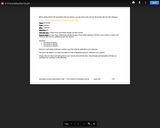
This activity helps educators understand the process of conferencing with learners more deeply by role-playing the scenario from the perspective of an educator, learner, and observer.
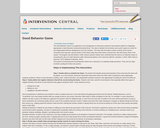
The Good Behavior Game is an approach to the management of classrooms behaviors that rewards children for displaying appropriate on-task behaviors during instructional times. The class is divided into two teams and a point is given to a team for any inappropriate behavior displayed by one of its members. The team with the fewest number of points at the Game's conclusion each day wins a group reward. If both teams keep their points below a preset level, then both teams share in the reward. The program was first tested in 1969; several research articles have confirmed that the Game is an effective means of increasing the rate of on-task behaviors while reducing disruptions in the classroom (Barrish, Saunders, & Wolf, 1969; Harris & Sherman, 1973; Medland & Stachnik, 1972).
The process of introducing the Good Behavior Game into a classroom is a relatively simple procedure. There are five steps involved in putting the Game into practice.
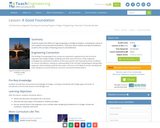
Students explore the effects of regional geology on bridge foundation, including the variety of soil conditions found beneath foundations. They learn about shallow and deep foundations, as well as the concepts of bearing pressure and settlement.

Using plastic straws, wire, batteries and iron nails, student teams build and test two versions of electromagnets one with and one without an iron nail at its core. They test each magnet's ability pick up loose staples, which reveals the importance of an iron core to the magnet's strength. Students also learn about the prevalence and importance of electromagnets in their everyday lives.
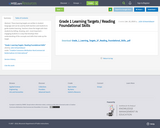
Abstract: These learning targets are written in student language and can be used by both teachers and students to guide student learning. Teachers share the target with their students by telling, showing, and—most important—engaging students in a way that develops their understanding of the concepts and skills that make up the target.
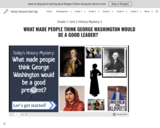
This lesson is the second part of the History's Mysteries unit, "What Makes a Good Leader?" In this lesson, students will study different situations that forced George Washington to learn leadership skills. By using George Washington as an example, students will learn that an important leadership skill is to ask for help. Using George Washington as an example, students will think of other leaders who displayed different types of leadership skills.
This lesson is part of a unit containing the following lessons:
Grade 1: Unit 2 History Mystery 1: WHAT MAKES SOMEONE A GOOD LEADER?
Grade 1: Unit 2 History Mystery 3: DO GOOD LEADERS ALWAYS DO GOOD THINGS?
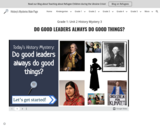
This lesson is the third and final part of the History's Mysteries unit, "What Makes a Good Leader?" In this lesson, students explore that leaders often make complex decisions and don’t always display positive leadership traits. While learning about George Washington’s use of slave labor throughout his life, students realize that even leaders are rarely perfect and can make poor decisions. This difficult topic is displayed in through the use of images and pictures and discussed in vocabulary appropriate for young learners.
This lesson is part of a unit containing the following lessons:
Grade 1: Unit 2 History Mystery 1: WHAT MAKES SOMEONE A GOOD LEADER?
Grade 1: Unit 2 History Mystery 2: WHAT MADE PEOPLE THINK GEORGE WASHINGTON WOULD BE A GOOD LEADER?
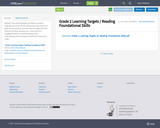
Abstract: These learning targets are written in student language and can be used by both teachers and students to guide student learning. Teachers share the target with their students by telling, showing, and—most important—engaging students in a way that develops their understanding of the concepts and skills that make up the target.
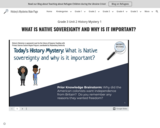
In this lesson, students will learn about some elements of Native sovereignty. They will learn what a Native nation is and why sovereignty is so important to a nation. The lesson focuses on why nations need land, why history is important, and how shared culture is also part of sovereignty. The lesson focuses on Native nations today because it is important to talk about Native nations today to break stereotypes that Native people only existed in the past.
This lesson is part of a Unit that includes the following lessons:
Grade 3 Unit 2 History Mystery 1: WHAT IS NATIVE SOVEREIGNTY AND WHY IS IT IMPORTANT?
Grade 3 Unit 2 History Mystery 2: WHAT CAN DIFFERENT MAPS TELL US ABOUT NATIVE SOVEREIGNTY AND NATIVE LAND?
Grade 3 Unit 2 History Mystery 3: WHAT STRATEGIES TO NATIVE NATIONS USE TO PROTECT THEIR SOVEREIGNTY DURING THE AMERICAN REVOLUTION (1)?
Grade 3 Unit 2 History Mystery 4: WHAT STRATEGIES TO NATIVE NATIONS USE TO PROTECT THEIR SOVEREIGNTY DURING THE AMERICAN REVOLUTION (2)?
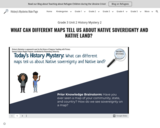
In this lesson, students will look at 3 maps to learn about where the ancestral tribal lands of four Native nations are located. The four nations are the Iroquois Confederacy (made of 5 nations), the Cherokee Nation, the Chickasaw Nation, and the Western Abenaki nation. Students will label all four groups on three different maps and as they look at each map they will consider how the land is represented on the map and how that might impact how people understand Native land and Native sovereignty.
This lesson is part of a Unit that includes the following lessons:
Grade 3 Unit 2 History Mystery 1: WHAT IS NATIVE SOVEREIGNTY AND WHY IS IT IMPORTANT?
Grade 3 Unit 2 History Mystery 2: WHAT CAN DIFFERENT MAPS TELL US ABOUT NATIVE SOVEREIGNTY AND NATIVE LAND?
Grade 3 Unit 2 History Mystery 3: WHAT STRATEGIES TO NATIVE NATIONS USE TO PROTECT THEIR SOVEREIGNTY DURING THE AMERICAN REVOLUTION (1)?
Grade 3 Unit 2 History Mystery 4: WHAT STRATEGIES TO NATIVE NATIONS USE TO PROTECT THEIR SOVEREIGNTY DURING THE AMERICAN REVOLUTION (2)?
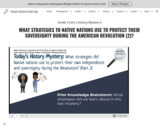
In this mystery, students will look at primary and secondary sources from the four Native nations we have been studying: Haudenosaunee/Iroquois, Cherokee, Chickasaw, and Western Abenaki. They will match their five different strategy cards with the primary and secondary sources. After reading each source, students will determine which strategy that nation used to protect their land and sovereignty during the American Revolution. After each source, students will read a brief summary that will give more information about the strategies used. Student handouts will allow students to mark up the primary and secondary sources, pick a strategy and then explain their reasoning.
This lesson is part of a Unit that includes the following lessons:
Grade 3 Unit 2 History Mystery 1: WHAT IS NATIVE SOVEREIGNTY AND WHY IS IT IMPORTANT?
Grade 3 Unit 2 History Mystery 2: WHAT CAN DIFFERENT MAPS TELL US ABOUT NATIVE SOVEREIGNTY AND NATIVE LAND?
Grade 3 Unit 2 History Mystery 3: WHAT STRATEGIES TO NATIVE NATIONS USE TO PROTECT THEIR SOVEREIGNTY DURING THE AMERICAN REVOLUTION (1)?
Grade 3 Unit 2 History Mystery 4: WHAT STRATEGIES TO NATIVE NATIONS USE TO PROTECT THEIR SOVEREIGNTY DURING THE AMERICAN REVOLUTION (2)?
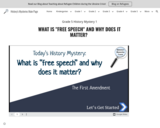
The lesson begins with a brief introduction to the mystery and then a quick context video to help students understand how and why we have a Bill of Rights. In this lesson, students will explore the importance of free speech in American society by analyzing the words of the 1st Amendment; learning new vocabulary; reading an overview of the history of the 1st amendment; and looking at 4 key reasons why free speech is important in America. For the student activity, students will explore how each of the 4 key reasons for speech relates to their own lives and ideas.
This lesson is part of a Unit that includes the following lessons:
Grade 5 History Mystery 1: WHAT IS "FREE SPEECH" AND WHY DOES IT MATTER?
Grade 5 History Mystery 2: DOES "FREE SPEECH" MEAN I CAN SAY WHATEVER I WANT?
Grade 5 History Mystery 3:WHAT CAN I SAY IN SCHOOL?

In this lesson, students will learn about how the freedom of speech is limited. Students will predict, read about and apply their knowledge of three restrictions on the freedom of speech.
This lesson is part of a Unit that includes the following lessons:
Grade 5 History Mystery 1: WHAT IS "FREE SPEECH" AND WHY DOES IT MATTER?
Grade 5 History Mystery 2: DOES "FREE SPEECH" MEAN I CAN SAY WHATEVER I WANT?
Grade 5 History Mystery 3:WHAT CAN I SAY IN SCHOOL?

: In this lesson, students will learn about how “freedom of speech” is applied in schools. Students will begin by brainstorming the meaning of “free speech” from prior lessons and then brainstorming about how they think speech might be limited in schools. Then students will learn about speech rights in school by completing a reading and watching a short video. For the activity, students will look at school-based scenarios and decide whether or not they think a school could limit student speech.’
This lesson is part of a Unit that includes the following lessons:
Grade 5 History Mystery 1: WHAT IS "FREE SPEECH" AND WHY DOES IT MATTER?
Grade 5 History Mystery 2: DOES "FREE SPEECH" MEAN I CAN SAY WHATEVER I WANT?
Grade 5 History Mystery 3:WHAT CAN I SAY IN SCHOOL?
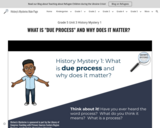
In this mystery, students will learn the meaning of “due process”, where due process rights are in the Constitution, and the history of where American due process rights came from. Students will begin by figuring out the meaning of the term. They will then examine the Bill of Rights and create Due Process Amendment Cards that they will use for this and additional mysteries in this unit. Students will sort the due process rights in the 4th-8th Amendments into the categories before, during and after trial. The will end the mystery by learning about the history of due process including the Magna Carta and due process rights in colonial America.
This lesson is part of a Unit that includes the following lessons:
Grade 5 Unit 3 History Mystery 1: WHAT IS "DUE PROCESS" AND WHY DOES IT MATTER?
Grade 5 Unit 3 History Mystery 2: HOW AND WHY DO PEOPLE FIGHT FOR DUE PROCESS RIGHTS?
Grade 5 Unit 3 History Mystery 3: DO STUDENTS HAVE THE RIGHT TO PRIVACY IN SCHOOL?
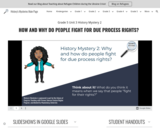
In this mystery, students will learn about three due process champions through the History Mystery questions “Why and how do people fight for due process rights?” The mystery begins by helping students understand what it means to fight for rights and how a person might petition for their rights. Then the mystery takes students through three due process champion stories of John Peter Zenger, Fred Korematsu, and Clarence Gideon. Each story starts with an introduction reading and video. Then students work in groups to investigate a primary source or sources related to each story with the guidance of an investigation packet. Each story helps students answer the history mystery question.
This lesson is part of a Unit that includes the following lessons:
Grade 5 Unit 3 History Mystery 1: WHAT IS "DUE PROCESS" AND WHY DOES IT MATTER?
Grade 5 Unit 3 History Mystery 2: HOW AND WHY DO PEOPLE FIGHT FOR DUE PROCESS RIGHTS?
Grade 5 Unit 3 History Mystery 3: DO STUDENTS HAVE THE RIGHT TO PRIVACY IN SCHOOL?
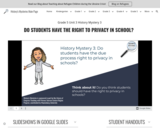
In this mystery, students will learn about what due process rights young people have in and out of school. They will start by learning some background information and then specifically learn about the Reasonable Suspicion Standard for conducting student searches in schools. Students will then have two activities to practice applying the standard. The lesson will culminate with students analyzing real court cases and using their knowledge to apply the Reasonable Suspicion Standard.
This lesson is part of a Unit that includes the following lessons:
Grade 5 Unit 3 History Mystery 1: WHAT IS "DUE PROCESS" AND WHY DOES IT MATTER?
Grade 5 Unit 3 History Mystery 2: HOW AND WHY DO PEOPLE FIGHT FOR DUE PROCESS RIGHTS?
Grade 5 Unit 3 History Mystery 3: DO STUDENTS HAVE THE RIGHT TO PRIVACY IN SCHOOL?
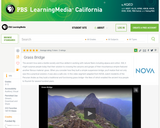
In this video segment adapted from NOVA, watch residents of the Peruvian Andes build a suspension bridge made entirely of grass. The ancient Inca were a textile society and thus skilled in working with natural fibers including alpaca and cotton. Still, it might surprise people today that their solution to crossing the canyons and gorges of their mountainous empire featured another fibrous material: grass. When you consider how they built a simple suspension bridge, you'll realize that not only was this a practical solution, it was also a safe one. In this video segment adapted from NOVA, watch residents of the Peruvian Andes as they build a traditional and functioning grass bridge the likes of which enabled the ancient Inca people to flourish for several hundred years. Grades 3-12.
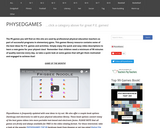
Great website with instructional videos of K-8 PE games broken down by grade level and categories.